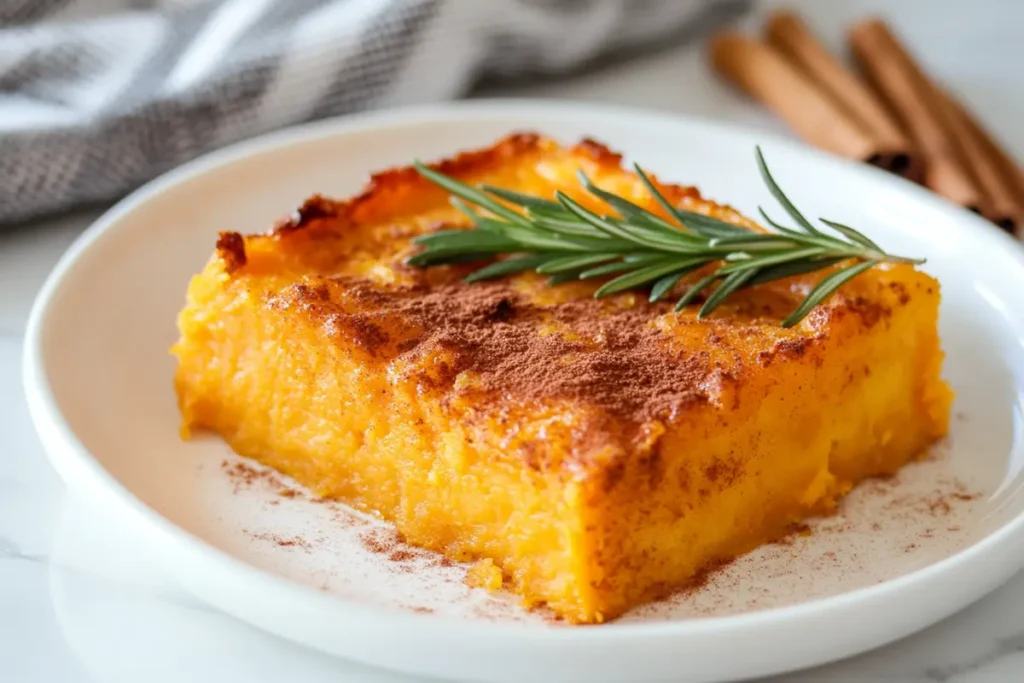Introduction
Sweet potato casserole isn’t just a side dish—it’s a holiday favorite known for its creamy, custard-like texture, thanks to eggs. This guide explores how eggs enhance texture, flavor, and structure while offering tips, alternatives, and solutions to perfect your recipe. Let’s uncover why eggs are a key ingredient in this classic dish!
The Role of Eggs in Sweet Potato Casserole Introduction
Purpose of Adding Eggs in Sweet Potato Casserole
Purpose of Adding Eggs in Sweet Potato Recipes
Eggs are a multifunctional ingredient in sweet potato casserole recipes, serving three primary roles:
- Binding: Eggs hold the mixture together, ensuring it doesn’t crumble when sliced.
- Enhancing Texture: They add a luxurious creaminess and a custard-like quality.
- Leavening: By incorporating air into the mixture, eggs help create a light and airy dish.
Without eggs in sweet potato recipes, the casserole might lack the cohesion and structure that make it such a satisfying addition to any meal.
Contribution of Eggs to Casserole Structure
The proteins in eggs are crucial for giving the sweet potato casserole its firm-yet-tender structure. As eggs bake, their proteins coagulate, forming a matrix that holds the sweet potato mixture together. This structural integrity ensures the dish slices neatly and maintains its shape, whether served warm or at room temperature.
Enhancing Creaminess with Eggs in Sweet Potato Casserole
Eggs add rich creaminess to sweet potato casserole with eggs by emulsifying the fats and liquids in the recipe. This creates a smooth and uniform consistency, ensuring that every bite is silky and indulgent. Combined with butter and milk, eggs achieve the custard-like texture that sets this sweet potato casserole apart from simple mashed sweet potatoes.
Binding Agent
In baking, eggs act as a natural glue, binding ingredients like mashed sweet potatoes, butter, and sugar into a cohesive mixture. This is especially important in sweet potato casserole, where the combination of wet and dry ingredients needs a unifying element to avoid separation or crumbling.
Leavening Properties
Eggs also contribute to the casserole’s lightness. When whisked, eggs incorporate air into the mixture, which expands during baking to create a fluffy texture. This subtle rise ensures the casserole isn’t overly dense or heavy, striking the perfect balance between creamy and airy.
Moisture Retention
The water content in eggs plays a crucial role in retaining moisture during baking. This prevents the casserole from drying out, ensuring every spoonful is moist and flavorful. Eggs also help balance the natural starchiness of sweet potatoes, adding a luscious smoothness to the final dish.
Stability
Stability is a key benefit of adding eggs. As the casserole cools, the egg proteins form a gel-like structure that holds everything together. This prevents the dish from becoming runny or separating, even after reheating. The result is a consistently firm and sliceable casserole.
Nutritional Benefits eggs in Sweet Potato Casserole
Eggs are packed with nutrients that boost the overall health benefits of sweet potato casserole:
- Protein: Makes the dish more filling and satisfying.
- Vitamins: Including B12, D, and choline, which support metabolism and brain health.
- Healthy Fats: Enhance flavor and aid in the absorption of fat-soluble vitamins.
By incorporating eggs, you not only elevate the dish’s flavor but also its nutritional value.
Flavor Enhancement of sweet potato casserole.
Eggs subtly enhance the flavor profile of sweet potato casserole. Their richness complements the sweetness of the potatoes, while their emulsifying properties blend the spices, sugar, and butter into a harmonious mix. This ensures every ingredient shines without overpowering the others.
Comparing Egg-Enhanced and Egg-Free Casseroles
When comparing egg-enhanced casseroles to those made without eggs, the difference is clear:
- With Eggs: Creamy, stable, and slightly airy.
- Without Eggs: Denser, less cohesive, and prone to dryness.
While egg-free versions can still be delicious with the right substitutes, eggs provide a unique texture and flavor that is hard to replicate.
Techniques for Incorporating Eggs in sweet potato casserole

Preparing Eggs in sweet potato casserole
Proper egg preparation is crucial for achieving the perfect texture in sweet potato casserole. Follow these tips:
- Bring Eggs to Room Temperature: Cold eggs can cause the mixture to curdle when combined with warm sweet potatoes. Let the eggs sit at room temperature for 15–20 minutes before using them.
- Lightly Beat the Eggs: Beating the eggs before adding them ensures they mix evenly into the sweet potato base, preventing clumps.
- Temper the Eggs: To avoid scrambling, gradually add a small amount of the warm sweet potato mixture to the eggs while whisking. This gently raises the eggs’ temperature before full incorporation.
Importance of Whisking
Whisking eggs properly is essential for creating a casserole with a light and cohesive texture. Here’s why:
- Incorporates Air: Whisking introduces air into the mixture, helping to create a fluffy casserole.
- Ensures Even Distribution: A smooth egg mixture ensures that the binding properties are consistent throughout the dish.
Use a hand whisk or an electric mixer on low speed for best results, stopping when the eggs are fully combined and frothy.
Preventing Overmixing and Curdling
Overmixing the casserole mixture can lead to a gummy texture, while improperly handled eggs may curdle. To prevent these issues:
- Fold, Don’t Stir: Once the eggs are incorporated, gently fold the mixture to preserve its airy texture.
- Consistent Temperature: Bake the casserole at 350°F (175°C) to ensure even cooking and prevent the eggs from curdling.
Balancing Ingredients with Eggs

Adjusting Sweetness and Spices
Eggs subtly affect the flavor balance of the casserole, so adjusting the sweetness and spices is important:
- Reduce Sugar Slightly: Eggs add richness, which can make the dish seem sweeter. Start with less sugar and adjust to taste.
- Enhance Spices: Cinnamon, nutmeg, and vanilla pair well with eggs, creating a warm and inviting flavor profile.
Balancing these elements ensures a dish that is deliciously harmonious.
Egg-to-Potato Ratio
The correct egg-to-potato ratio is key to achieving the desired texture. A general guideline is:
- 2 large eggs for every 4 cups of mashed sweet potatoes.
For a denser casserole, increase the number of eggs slightly. For a softer texture, reduce the eggs by one. This ratio creates a dish that is firm yet creamy, with a melt-in-your-mouth consistency.
Complementary Dairy Options of sweet potato casserole.
Dairy plays an important role in enhancing the texture and flavor of the casserole. Consider these options:
- Dairy Milk (Whole, 2%, or Cream): Adds richness and pairs beautifully with eggs.
- Non-Dairy Alternatives: Almond milk, coconut milk, or oat milk work well for lighter or vegan versions.
Choose a milk option that complements the flavors of your casserole while aligning with dietary preferences.
Customizing sweet potato casserole dish.
Incorporating Toppings
Toppings add a layer of indulgence to sweet potato casserole. Popular options include:
- Marshmallows: Adds a gooey sweetness. Best broiled for a golden, caramelized finish.
- Streusel: Made with brown sugar, butter, and pecans for a crunchy texture. Adds a nutty balance to the dish’s sweetness.
These toppings can be combined for a casserole that’s both crunchy and creamy.
Exploring Savory Variations
For those who prefer a savory twist, eggs can also enhance the umami flavors of a savory casserole. Try:
- Cheeses: Parmesan, Gruyere, or sharp cheddar for richness.
- Herbs and Spices: Add rosemary, thyme, or smoked paprika for a gourmet flair.
- Savory Toppings: Use breadcrumbs or crumbled bacon instead of sweet toppings.
This variation transforms sweet potato casserole into a versatile main dish.
Adding Nuts, Spices, or Fruits
Additional ingredients can elevate the casserole’s texture and flavor. Consider:
- Chopped Pecans or Walnuts: Adds crunch and pairs well with sweet potatoes.
- Dried Fruits (Cranberries, Raisins): Introduces a chewy sweetness.
- Extra Spices: Experiment with cardamom or ginger for a unique twist.
These elements make the casserole visually appealing and texturally diverse.
Vegan and Egg-Free Alternatives
For vegan or allergy-friendly options, egg substitutes can mimic the texture and binding properties of eggs. Try:
- Flaxseed Meal or Chia Seeds: Mixed with water, these create a gel-like consistency.
- Silken Tofu: Blends smoothly into the sweet potato mixture for a custard-like texture.
- Unsweetened Applesauce or Mashed Bananas: Adds moisture and a subtle sweetness.
These alternatives allow you to enjoy the essence of sweet potato casserole while meeting dietary needs.
Achieving a Custard-Like Texture
To achieve the ideal custard-like consistency, focus on these key elements:
- Egg-to-Potato Ratio: Maintain 2 large eggs for every 4 cups of mashed sweet potatoes.
- Incorporate Dairy: Use milk or cream to enhance smoothness.
- Bake Gently: Even heat ensures the mixture sets without overcooking.
The result is a casserole that’s silky and decadent.
Tips for Making Fluffy and Light Casseroles
A light and fluffy casserole requires incorporating air into the mixture. Here’s how:
- Whisk Eggs Thoroughly: Beat until frothy before adding them to the sweet potatoes.
- Avoid Overmixing: Fold the mixture gently to retain the airiness.
These techniques ensure a delicately textured casserole that’s a crowd-pleaser.
Preparing the Dish Ahead of Time
Sweet potato casserole can be prepped in advance for convenience:
- Assemble: Mix the sweet potato base and refrigerate it, covered, for up to 24 hours.
- Add Toppings Later: Apply marshmallows or streusel just before baking to keep them fresh.
When ready to bake, allow the casserole to sit at room temperature for 20 minutes before placing it in the oven.
Reheating and Maintaining Texture
To reheat without losing texture:
- Oven Method: Cover the casserole with foil and warm at 325°F (163°C) for 15–20 minutes.
- Avoid Microwave: This can cause the eggs to dry out or overcook.
Reheating gently preserves the casserole’s creamy and fluffy qualities.
Adjusting the Recipe for Large Gatherings
For holiday feasts or big gatherings, scaling up the recipe is simple:
- Increase Proportionally: Maintain the same egg-to-potato ratio (2 eggs per 4 cups of sweet potatoes).
- Use Larger Dishes: A larger casserole dish ensures even cooking.
- Bake in Batches: If doubling or tripling the recipe, bake in multiple smaller dishes for consistency.
With these adjustments, your casserole will be a hit, whether you’re serving 10 or 50 guests.
Frequently Asked Questions (FAQs) About Eggs in Sweet Potato Casserole
Can I Make Sweet Potato Casserole Without Eggs?
Yes, you can make sweet potato casserole without eggs by using substitutes such as flaxseed meal, chia seeds, silken tofu, or unsweetened applesauce. However, these substitutes may slightly alter the texture and flavor.
How Many Eggs Should I Use in a Standard Sweet Potato Casserole?
The general rule is 2 large eggs for every 4 cups of mashed sweet potatoes. This ensures the casserole is cohesive, creamy, and stable.
What’s the Best Way to Incorporate Eggs Without Scrambling Them?
To avoid scrambling, temper the eggs by gradually mixing a small amount of the warm sweet potato mixture into the eggs while whisking. Then, combine the tempered eggs with the rest of the mixture.
Do Eggs Affect the Flavor of the Casserole?
Eggs subtly enhance the flavor by blending and balancing the sweetness, spices, and buttery richness of the casserole. They don’t overpower the dish but contribute to its overall harmony.
Can I Prepare Sweet Potato Casserole with Eggs Ahead of Time?
Yes, you can assemble the casserole in advance, including the eggs. Store it in the refrigerator for up to 24 hours and bake it just before serving.
How Can I Ensure My Casserole Is Fluffy and Light?
For a fluffy casserole, whisk the eggs thoroughly before adding them to the mixture, and gently fold to avoid overmixing. This technique helps retain air, creating a lighter texture.
Conclusion
Eggs are the unsung heroes of sweet potato casserole, transforming this dish into a creamy, custard-like masterpiece. By understanding their role, mastering techniques for incorporating them, and exploring alternatives, you can create a casserole that’s perfect for any occasion. Whether you stick to tradition or customize with toppings and flavors, the right approach to eggs ensures a dish that’s as delicious as it is memorable.

